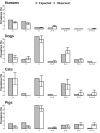Co-infection of intestinal helminths in humans and animals in the Philippines
- PMID: 35169848
- PMCID: PMC9356178
- DOI: 10.1093/trstmh/trac002
Co-infection of intestinal helminths in humans and animals in the Philippines
Abstract
Background: A large number of studies have assessed risk factors for infection with soil-transmitted helminths (STH), but few have investigated the interactions between the different parasites or compared these between host species across hosts. Here, we assessed the associations between Ascaris, Trichuris, hookworm, strongyle and Toxocara infections in the Philippines in human and animal hosts.
Methods: Faecal samples were collected from humans and animals (dogs, cats and pigs) in 252 households from four villages in southern Philippines and intestinal helminth infections were assessed by microscopy. Associations between worm species were assessed using multiple logistic regression.
Results: Ascaris infections showed a similar prevalence in humans (13.9%) and pigs (13.7%). Hookworm was the most prevalent infection in dogs (48%); the most prevalent infection in pigs was strongyles (42%). The prevalences of hookworm and Toxocara in cats were similar (41%). Statistically significant associations were observed between Ascaris and Trichuris and between Ascaris and hookworm infections in humans, and also between Ascaris and Trichuris infections in pigs. Dual and triple infections were observed, which were more common in dogs, cats and pigs than in humans.
Conclusions: Associations are likely to exist between STH species in humans and animals, possibly due to shared exposures and transmission routes. Individual factors and behaviours will play a key role in the occurrence of co-infections, which will have effects on disease severity. Moreover, the implications of co-infection for the emergence of zoonoses need to be explored further.
Keywords: Helminths; Philippines; Toxocara; co-infection; epidemiology; strongyle.
© The Author(s) 2022. Published by Oxford University Press on behalf of Royal Society of Tropical Medicine and Hygiene.
Figures


Similar articles
-
A systematic review and meta-analysis of human and zoonotic dog soil-transmitted helminth infections in Australian Indigenous communities.PLoS Negl Trop Dis. 2022 Oct 24;16(10):e0010895. doi: 10.1371/journal.pntd.0010895. eCollection 2022 Oct. PLoS Negl Trop Dis. 2022. PMID: 36279298 Free PMC article.
-
Fine mapping of Ascaris lumbricoides, Trichuris trichiura and hookworm infections in sub-districts of Makenene in Centre Region of Cameroun.Sci Rep. 2022 Aug 17;12(1):13935. doi: 10.1038/s41598-022-18285-7. Sci Rep. 2022. PMID: 35978014 Free PMC article.
-
Factors associated with soil-transmitted helminths infection in Benin: Findings from the DeWorm3 study.PLoS Negl Trop Dis. 2021 Aug 17;15(8):e0009646. doi: 10.1371/journal.pntd.0009646. eCollection 2021 Aug. PLoS Negl Trop Dis. 2021. PMID: 34403424 Free PMC article. Clinical Trial.
-
Helminths, polyparasitism, and the gut microbiome in the Philippines.Int J Parasitol. 2020 Mar;50(3):217-225. doi: 10.1016/j.ijpara.2019.12.008. Epub 2020 Mar 3. Int J Parasitol. 2020. PMID: 32135180
-
Prevalence of soil-transmitted helminth infections in HIV patients: a systematic review and meta-analysis.Sci Rep. 2023 Jul 8;13(1):11055. doi: 10.1038/s41598-023-38030-y. Sci Rep. 2023. PMID: 37422549 Free PMC article.
Cited by
-
Constructing the first comorbidity networks in companion dogs in the Dog Aging Project.PLoS Comput Biol. 2025 Aug 14;21(8):e1012728. doi: 10.1371/journal.pcbi.1012728. eCollection 2025 Aug. PLoS Comput Biol. 2025. PMID: 40811246 Free PMC article.
-
Worldwide absence of canonical benzimidazole resistance-associated mutations within β-tubulin genes from Ascaris.Parasit Vectors. 2024 May 16;17(1):225. doi: 10.1186/s13071-024-06306-5. Parasit Vectors. 2024. PMID: 38755679 Free PMC article.
-
Risk mapping and socio-ecological drivers of soil-transmitted helminth infections in the Philippines: a spatial modelling study.Lancet Reg Health West Pac. 2023 Nov 22;43:100974. doi: 10.1016/j.lanwpc.2023.100974. eCollection 2024 Feb. Lancet Reg Health West Pac. 2023. PMID: 38076323 Free PMC article.
-
Copromicroscopic Diagnosis and Prevalence of Parasitic Infections in Animals in Sitio Ibayo, San Mateo, Rizal, Philippines: Establishing a Sentinel Study for Zoonotic Disease Surveillance.Cureus. 2024 Dec 13;16(12):e75675. doi: 10.7759/cureus.75675. eCollection 2024 Dec. Cureus. 2024. PMID: 39811217 Free PMC article.
-
Toxocara cati Infection in Cats (Felis catus): A Systematic Review and Meta-Analysis.Animals (Basel). 2024 Mar 27;14(7):1022. doi: 10.3390/ani14071022. Animals (Basel). 2024. PMID: 38612261 Free PMC article. Review.
References
-
- World Health Organization . Soil-Transmitted Helminth Infections. Available at https://www.who.int/news-room/fact-sheets/detail/soil-transmitted-helmin... [accessed July 16, 2019].
-
- Betson M, Allen JI, Alonte Rico CAet al. . Zoonotic transmission of intestinal helminths in southeast Asia: implications for control and elimination. Adv Parasitol. 2020;108:48–131. - PubMed
-
- Jourdan PM, Lamberton PHL, Fenwick Aet al. . Soil-transmitted helminth infections. Lancet. 2018;391(10117):252–65. - PubMed
-
- George S. The role of domestic animals in the transmission of soil transmitted helminth infectious in humans. PhD Thesis, Department of Virology, Parasitology and Immunology, Faculty of Veterinary Medicine, Ghent University, Salisburylaan;2016.
-
- World Health Organization . Zoonoses. Available at https://www.who.int/news-room/fact-sheets/detail/zoonoses [accessed July 29, 2020].
Publication types
MeSH terms
Substances
Supplementary concepts
Grants and funding
LinkOut - more resources
Full Text Sources
Miscellaneous

